
Dame Agatha Mary Clarissa Christie, Lady Mallowan, was an English writer known for her 66 detective novels and 14 short story collections, particularly those revolving around fictional detectives Hercule Poirot and Miss Marple. She also wrote the world's longest-running play, the murder mystery The Mousetrap, which has been performed in the West End of London since 1952. A writer during the "Golden Age of Detective Fiction", Christie has been called the "Queen of Crime"—a moniker which is now trademarked by her estate—or the "Queen of Mystery". She also wrote six novels under the pseudonym Mary Westmacott. In 1971, she was made a Dame (DBE) by Queen Elizabeth II for her contributions to literature. Guinness World Records lists Christie as the best-selling fiction writer of all time, her novels having sold more than two billion copies.
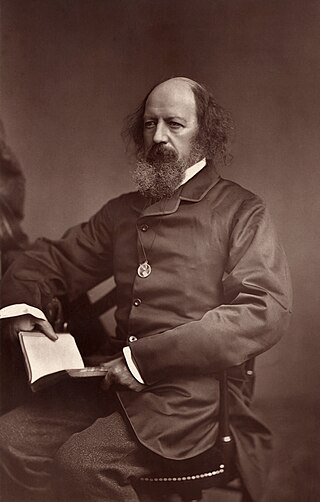
Alfred Tennyson, 1st Baron Tennyson was an English poet. He was the Poet Laureate during much of Queen Victoria's reign. In 1829, Tennyson was awarded the Chancellor's Gold Medal at Cambridge for one of his first pieces, "Timbuktu". He published his first solo collection of poems, Poems, Chiefly Lyrical, in 1830. "Claribel" and "Mariana", which remain some of Tennyson's most celebrated poems, were included in this volume. Although described by some critics as overly sentimental, his verse soon proved popular and brought Tennyson to the attention of well-known writers of the day, including Samuel Taylor Coleridge. Tennyson's early poetry, with its medievalism and powerful visual imagery, was a major influence on the Pre-Raphaelite Brotherhood.

Murder on the Orient Express is a work of detective fiction by English writer Agatha Christie featuring the Belgian detective Hercule Poirot. It was first published in the United Kingdom by the Collins Crime Club on 1 January 1934. In the United States, it was published on 28 February 1934, under the title of Murder in the Calais Coach, by Dodd, Mead and Company. The UK edition retailed at seven shillings and sixpence (7/6) and the US edition at $2.

The Mysterious Affair at Styles is the first detective novel by British writer Agatha Christie, introducing her fictional detective Hercule Poirot. It was written in the middle of the First World War, in 1916, and first published by John Lane in the United States in October 1920 and in the United Kingdom by The Bodley Head on 21 January 1921.

The Mirror Crack'd from Side to Side, a novel by Agatha Christie, was published in the UK in 1962 and a year later in the US under the title The Mirror Crack'd. The story features amateur detective Miss Marple solving a mystery in St. Mary Mead.
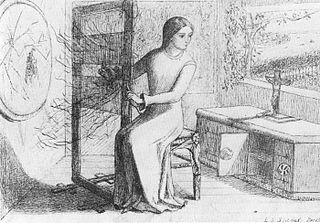
"The Lady of Shalott" is a lyrical ballad by the 19th-century English poet Alfred Tennyson and one of his best-known works. Inspired by the 13th-century Italian short prose text Donna di Scalotta, the poem tells the tragic story of Elaine of Astolat, a young noblewoman stranded in a tower up the river from Camelot. Tennyson wrote two versions of the poem, one published in 1832, of 20 stanzas, the other in 1842, of 19 stanzas, and returned to the story in "Lancelot and Elaine". The vivid medieval romanticism and enigmatic symbolism of "The Lady of Shalott" inspired many painters, especially the Pre-Raphaelites and their followers, as well as other authors and artists.

Taken at the Flood is a work of detective fiction by British writer Agatha Christie, first published in the US by Dodd, Mead and Company in March 1948 under the title of There is a Tide. .. and in the UK by the Collins Crime Club in the November of the same year under Christie's original title. The US edition retailed at $2.50 and the UK edition at eight shillings and sixpence (8/6). It features her famous Belgian detective, Hercule Poirot, and is set in 1946.

Mrs McGinty's Dead is a work of detective fiction by British writer Agatha Christie, first published in the US by Dodd, Mead and Company in February 1952 and in the UK by the Collins Crime Club on 3 March the same year. The US edition retailed at $2.50 and the UK edition at nine shillings and sixpence (9/6). The Detective Book Club issued an edition, also in 1952, as Blood Will Tell.
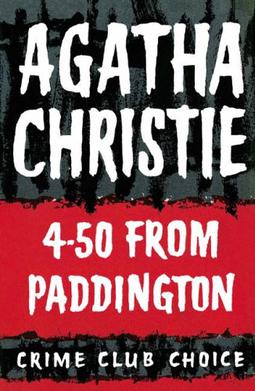
4.50 from Paddington is a detective fiction novel by Agatha Christie, first published in November 1957 in the United Kingdom by Collins Crime Club. This work was published in the United States at the same time as What Mrs. McGillicuddy Saw!, by Dodd, Mead. The novel was published in serial form before the book was released in each nation, and under different titles. The US edition retailed at $2.95.
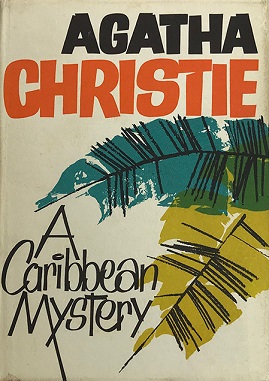
A Caribbean Mystery is a work of detective fiction by British writer Agatha Christie, first published in the UK by the Collins Crime Club on 16 November 1964 and in the United States by Dodd, Mead and Company the following year. The UK edition retailed at sixteen shillings (16/-) and the US edition at $4.50. It features the detective Miss Marple.
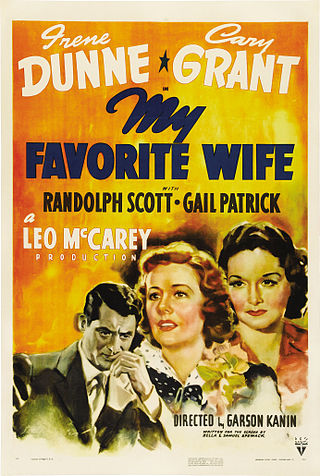
My Favorite Wife, released in the United Kingdom as My Favourite Wife, is a 1940 screwball comedy produced by Leo McCarey and directed by Garson Kanin.
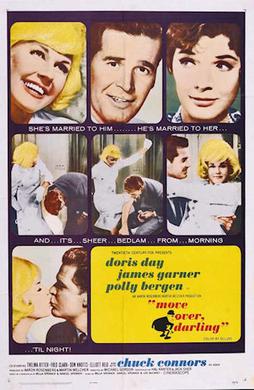
Move Over, Darling is a 1963 American comedy film starring Doris Day, James Garner, and Polly Bergen and directed by Michael Gordon filmed in DeLuxe Color and CinemaScope released by 20th Century Fox.

Too Many Husbands is a 1940 American romantic comedy film about a woman who loses her husband in a boating accident and remarries, only to have her first spouse reappear—yet another variation on the 1864 poem Enoch Arden by Alfred, Lord Tennyson. The film stars Jean Arthur, Fred MacMurray and Melvyn Douglas, and is based on the 1919 play Home and Beauty by W. Somerset Maugham, which was retitled Too Many Husbands when it came to New York. The film was directed by Wesley Ruggles.

Enoch Arden is a 1915 American short drama film directed by Christy Cabanne. It is based on the 1864 poem Enoch Arden by Tennyson. Prints of the film exists at the George Eastman House Motion Picture Collection and the UCLA Film and Television Archive.

Enoch Arden is a two-part 1911 short silent drama film, based on the 1864 Tennyson poem of the same name. It was directed by D. W. Griffith, starred Wilfred Lucas and featured Blanche Sweet. A print of the film survives in the film archive of the Library of Congress.
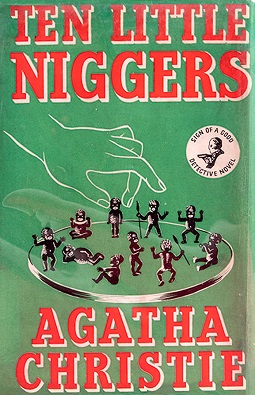
And Then There Were None is a mystery novel by the English writer Agatha Christie, who described it as the most difficult of her books to write. It was first published in the United Kingdom by the Collins Crime Club on 6 November 1939, as Ten Little Niggers, after an 1869 minstrel song that serves as a major plot element. The US edition was released in January 1940 with the title And Then There Were None, taken from the last five words of the song. Successive American reprints and adaptations use that title, though American Pocket Books paperbacks used the title Ten Little Indians between 1964 and 1986. UK editions continued to use the original title until 1985.

Nirmon is a 1966 Indian Konkani-language film. It was directed by A. Salam and produced by Frank Fernand. The film features C. Alvares, Shalini, Anthony D’Sa, Ophelia, Souza Ferrao, Antonette and Jacinto Vaz.
Enoch Arden is a 1914 British silent drama film directed by Percy Nash and starring Gerald Lawrence, Fay Davis and Ben Webster. It was based on the 1864 poem Enoch Arden by Alfred, Lord Tennyson.
"Enoch Arden" is a narrative poem published in 1864 by Alfred, Lord Tennyson.

Tangled Lives is a 1910 American silent short drama produced by the Thanhouser Company. The plot focuses on, John Hill, a bank cashier who decides to fakes his death after the manager finds his accounts are short. Before he can go through with the plan, a reporter interviews the wife, May, and decides to suppress the story because he has become infatuated with her. Five years pass, May and the reporter decide to marry, but John returns on the day of the wedding. Upon sneaking into the house, he sees their love and decides to disappear. As he attempts to leave he accidentally falls to his death and the reporter removes his body before he leads May to the altar. The film was described as a variant of Enoch Arden by one reviewer, but it differs in its execution. The cast and credits of the film are unknown, but a surviving film still shows the principal characters. The film was released on September 13, 1910, to positive reviews. The film is presumed lost.




















